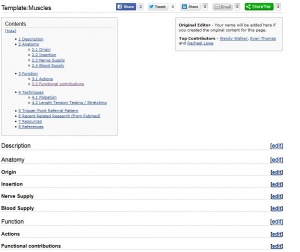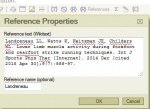What makes a good Physiopedia page
General Format[edit | edit source]
- Effective title
- Does the title already exist?
- Run a search for the page you want to create, or scan through the full list of Physiopedia articles.
- Is my title clear and capitalized correctly?
- The standard format for titles is to capitalize only the first letter of the first word, with the remaining words in lowercase.
- Try not to use ACRONYMS alone as titles, except in parentheses. Example: Anterior Cruciate Ligament (ACL).
- Does the title already exist?
- Template
- Did I use the appropriate template for the page I created?
- View the Physiopedia templates and choose one that fits the correct category (ie. joint, muscle, ligament).
- No template for the page you want to make?
- Use the new page template and create your own subheadings.
- Refer to: Adding Templates tutorial
- Did I use the appropriate template for the page I created?
- References
- Did I cite references using the references tool (<R> button) in the editing toolbar?
- Refer to: Adding References tutorial
- Did I use the Vancouver style of referencing?
- Did I cite references using the references tool (<R> button) in the editing toolbar?
Physiopedia-Specific Tips[edit | edit source]
The above three tips are general guidelines on what makes a good article, but what makes a Physiopedia page stand out? Below are the top ways to create an excellent addition to Physiopedia.
Physiotherapy-specific and Clinically-relevant[edit | edit source]
Physiopedia is a universally accessible, online resource for physiotherapists around the world. A good page, then, should convey knowledge of the profession and current best-evidence practice.
- Physiotherapy-specific
- Have I included sections/ headings that are relevant to physiotherapy?
- Good examples of this include: Pathology/Injury, Physiotherapy Techniques (Palpation, Stretch, Treatment techniques)
- These sections are included on the anatomy page templates (muscles, joints, ligaments).
- Additional relevant sections may include: Clinical Examination (such as Differential Diagnosis, Special Tests and Outcome Measures) and Physiotherapy Management/Intervention
- Good examples of this include: Pathology/Injury, Physiotherapy Techniques (Palpation, Stretch, Treatment techniques)
- Have I referenced journals/ articles/ books specific to physiotherapy?
- Have I included sections/ headings that are relevant to physiotherapy?
- Clinically-relevant
- Have I included sections for Clinically Relevant Anatomy, Evidence (for the technique or test described), and Recent Related Research?
- Recent Related Research
- This section links to recent PubMed research (via an RSS feed) on the article topic.
- Refer to: Adding PubMed Feed tutorial
- This section links to recent PubMed research (via an RSS feed) on the article topic.
Use of Relevant Media[edit | edit source]
Physiopedia is designed to be an educational and clinical tool, so visual references (including relevant images, videos and presentations) are great ways to enhance an article.
Examples of relevant media include:
 Images: Anatomy/anatomical, pathology/injury, diagrams, illustrations, etc.
Images: Anatomy/anatomical, pathology/injury, diagrams, illustrations, etc. Videos: Handling or rehabilitation protocols, exercises, or manual techniques (palpation, massage, range of motion).
Videos: Handling or rehabilitation protocols, exercises, or manual techniques (palpation, massage, range of motion). Lectures and Presentations: Anatomy/anatomical, clinical practice guidelines, physiotherapy management, diagnosis, imaging, etc.
Lectures and Presentations: Anatomy/anatomical, clinical practice guidelines, physiotherapy management, diagnosis, imaging, etc.
Did I correctly add/ reference images and videos?
- Refer to: Adding images and Adding video tutorials
- Specifically, media must meet the following usage requirements:
- Be copyright free – such as Grays Anatomy Illustrations (for images) and YouTube (for videos)
- Have a creative commons license that allows us to use it – such as Wikimedia Commons
- We must have permission to use the image/ video
- Be an image/ video that you have created
Did I correctly add/ reference presentations?
- Refer to: Adding Presentations tutorial
Examples of using media to create a quality Physiopedia page:










